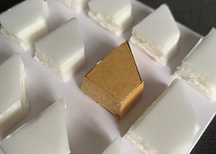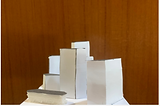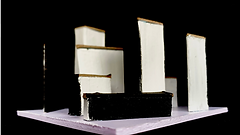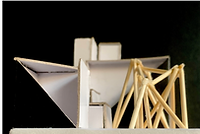Assignment 2:
Design Principles
8 design principles, 4 brains.
How will you marry them into a final hybrid model?
Meet The Team

Ching
Team leader

Aiai
Team member

Angel
Team member

Xin Yu
Team member









Progress
Project 2 is designed as a continuation from Project 1 to introduce and identify the design principles of architecture and design in utilising and creating order in an architectural composition and spatial arrangement. Order refers not simply to geometric regularity, but rather to a condition in which each part of a whole is properly disposed with reference to other parts and to its purpose so as to produce a harmonious arrangement.

Continuation of Assignment 1
A shape was extracted from patterns made in Assignment 1. This was done by all other teammates
Transformations
The shape was then transformed into a variety of other shapes. I made as much variety as possible to minimise the potential limitations faced in the later stage of design process. Attached is the previous two stages done by all other teammates

.png)
.png)
.png)
Emphasis - Ideation and Mockup
I was in charge of the design principle Emphasis. The shape was from the transformation stage (shape e), and emphasis was made with colour.
.png)
.png)
Emphasis - Progressive amendments
Some things that could be improved from the analysation of mockups was that the emphasis was not as strong as it could be. The piece was made to stand straight up instead, so there is emphasis in elevation views as well
.png)

.png)
.png)
Emphasis - Final Model: The Trapezoid
Colour and Structural emphasis within the 4x3 grid. Use of white on white (elements and base) for further bring out the colour emphasis


Variety - Ideation
As each teammate was in charge of two design principles, my second one is the design principle Variety. After researching and reading about Variety, ideation on the idea was created. The variety of shape transformations played a big part in this idea
.png)
.png)
.png)
.png)
.png)
Variety - Mockup
The idea was tested out using simple cardboard and paper.
Variety - Progressive amendments
Some things that could be improved from the analysation of mockups was that the Variety was not as strong as it could be. The top was strong, however the elevation views were a little bland. Thus, an idea to recreate solid-void illusion using black-on-black on the elevations emerged
.png)



Variety - Final Model: Solid-Void Variety
Variety in shapes seen on the top, and variety in height and solid seen from the elevations. Use of black on black to stimulate void. Attached is the document containing all 8 design principles by my team
.png)
.png)
Inspiration
Proceeding to integrate two design principles to one and consequently integrating the 4 into one hybrid model, inspiration was taken from a few prompts, namly: Covid-19, Modern Architecture and Frank Ghery's work

.png)
.png)
The process of Ideation
The integration of both Emphasis and Variety was a crucial progress. It was done in a way to have both entities integrate as a new identity. The idea was expressed in simple sketches and diagrams
Hybrid - Mockup
Testing out the ideas on sketch using cardboard and bamboo sticks, a few feedbacks could be deduced. The emphasis could be much stronger, in a way that spreads itself (almost like a parasite) into the tall and angular blocks.







Hybrid - Amendments
In consideration of future integration with other members' models, an bold decision to cut the base was made. It was so that a model below it could seamlessly connect to this.

Hybrid - Final Model
Like a parasite, Emphasis creeps from its corner. However, it finds its triangular self morphing into one of the blocks. Using solid and void, and the varied structures, emphasis is created on all views.
Attached is the full set of hybrid models from my teammates.



.png)
.png)
.png)
.png)
Final Model
Each hybrid model was combined digitally using Photoshop. In order to do this neatly, all team members took proper elevation pictures
Outcome
.png)
Reflection
Lifelong Learning
I learned to be independent yet a team-workers. I also became capable of locating, extracting, synthesising and utilising information effectively mockups and progressed accordingly yo final models. 've learned also to be intellectually engaged whenever feedbacks were given by my tutor
Discipline Specific Knowledge
I've learned to read up on design principles and ensure i understand how to apply them to my assignment
Global Perspectives
I was able to understand the value and power of design principles; it is everywhere, just unnoticed. I have also realized how powerful design principles are in controlling which emotions are to be conveyed in an art piece
Thinking and Problem-Solving Skills
I learned to think critically and creatively when combining design principles. I had to consider the integration and overall cohesiveness of the final model as well, despite all the models being done separately
Communication Skills
I've learned to communicate with my group members through texts and meetings. With this, we were able to work along each other well and finish the project with everyone feeling a part of the team.
Intrapersonal Skills
I've become capable of reflecting on my progress as a team member. I felt that I did my best, just like everyone else. Thinking back, I was self-reliant and carried my own weight as a team member. I also made my best effort to lead my team into being as efficient and inclusive as possible
Interpersonal Skills
I've learned to input my opinions in meetings and let the whole team be always informed, so everyone would share their thoughts and opinions in return. Our team members also communicated effectively and did their tasks mindfully so no team member had to rush theirs.
